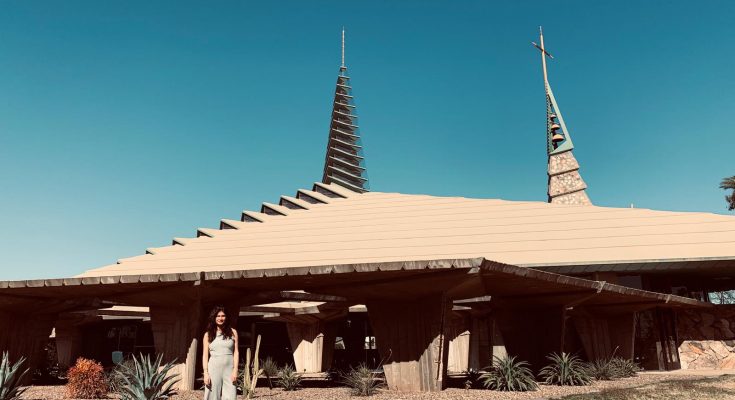“Designing in harmony with humanity and the environment” was the philosophy of Frank Lloyd Wright who lived from 1867 to 1959. He was considered America’s greatest architect and designer, and in my opinion, this rings true. He designed a house partly over a waterfall!
I first saw Frank Lloyd Wright’s unique buildings in the A4 pages of an album with dark gray cardboard covers. An American friend who came to visit me had found it in the lobby of the hotel where I was living temporarily. While waiting for me to come downstairs, he had a look at the small collection of art albums, culinary books and geography books that were on some shelves, and this one caught his attention.
–Do you know Frank Lloyd Wright?, he asked me with excitement when I appeared, as if he found a secret treasure.
–No, I replied with a mix of shame and curiosity. I realized he was an important person.

*
A few days later, I was out in the city to see for myself some of the 11 Frank Lloyd Wright designs that are in Phoenix, AZ. During his life, he designed over a 1,000 buildings (houses, hotels, churches, etc.) in a period of 70 years of work. He played a crucial role in the architectural movements of the 20th century and eight of his buildings, including “Fallingwater” (the house built partly on a waterfall, in southern Pennsylvania), were inscribed on the list of UNESCO World Heritage Sites.
Accidentally, my first stop was at the First Christian Church, built in 1973. As it was Saturday, the Church was closed (it’s open on Sundays mornings, with a protocol that says they respect the social distancing, mask wearing and sanitization rules).
So I walked around and looked from different angles at the triangular spire. I later found out that the roof was initially turquoise, but it was changed into a more conventional color, beige, to fit the religious vibe.
In front of the First Christian Church, designed by Frank LLoyd Wright
By walking under the exterior pylons, I could understand the harmony with the environment that Wright was always seeking for. It wasn’t just a building that simply rises on a piece of land, but its walls have continuations towards the ground, like the tentacles of an octopus.
The exterior of the First Christian Church, designed by Frank LLoyd
*
Right near the Phoenix Mountains Preserve, where silence is king, I saw the last house that Wright designed. It was built in 1967, eight years after he died, and is now privately owned.
Frank LLoyd Wright never got to see it, but it’s circular form made me think about wholeness – the symbol of a circle and of a great career.
*
I ended my tour with the house that Wright designed for one of his sons, David. When the father created it, its title was “How to live in the Southwest,” but now it’s known as “David and Glady’s house”.
When I got there, the gate was closed, so I took the picture through the fence, surrounded by olive trees. A man who told me he came from another state to visit his brother, also looked at the house through the fence. “I understood they wanted to demolish it,” he said.
He was right.
It seems like the spiral design was a prediction for the house’s trajectory. In 2012, it was sold to an owner that wanted to tear it down, but another investor bought it and saved it. His idea was to open it as a museum and art hub, but neighbors weren’t happy, due to the noise they thought these activities would generate. So the house was again on the market and it was bought in 2020 for over seven million dollars. The new owners, two of them being apprentices at Wright’s architectural school, are now restoring the house and installing a roof made of copper, as part of Wright’s original idea.
It looks like a story about money and power. But it’s also one about harmony. With humanity and the environment.
*(If you want to learn more about Frank Lloyd Wright, visit the page franklloydwright.org)




